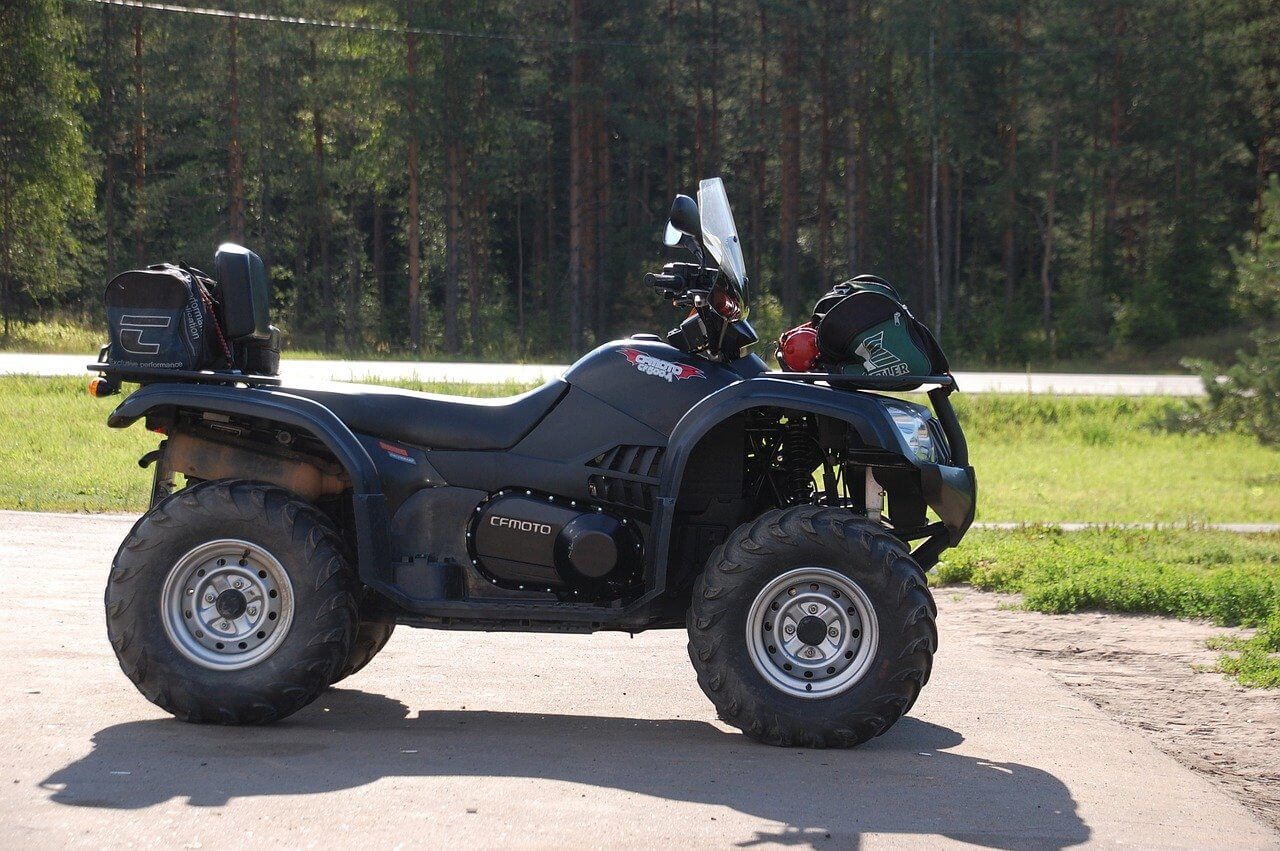If your ATV has hydraulic brakes, which it most likely does, you need to bleed them from time to time. Why is it important and how to bleed ATV brakes? Read on to learn more in this guide {+ watch 2 videos inside}.
What You'll Learn Today
Why Do You Need To Bleed ATV Brakes?

Bleeding ATV brakes flushes out old brake fluid, allowing you to add new brake fluid. It’s recommended that you replace brake fluid every time you replace your brake pads.
You may also need to bleed your ATV brakes to get rid of trapped air. Air in the cylinder or brake line can make your brake lever feel soft and squishy when you press it, seriously affecting braking performance.
Bleeding ATV brakes is a fairly easy process that you can do at home with basic tools. There are three ways to do it: the manual way, the vacuum method using a brake bleeder tool, and the reverse bleeding method.
What Do You Need to Bleed ATV Brakes?
Manual bleeding is more work and takes longer, but you don’t need any fancy tools.
The most important tools are a phillips screwdriver to open the brake fluid reservoir, and an 8mm wrench to operate the bleeder valve.
We also recommend having an empty bottle and a length of 5/16 inch clear tube.
This allows you to empty the old brake fluid into the bottle, rather than letting it spill on the ground where it can cause a mess and damage the environment.
Obviously, you also need new brake fluid on hand. Use the manufacturer-recommended brake fluid. Most ATVs use DOT 4 brake fluid.
We also recommend jacking up your ATV and removing the wheels for easier access to the bleed valve. But this is optional.
Finally, have someone around to help you. This is a two-person job. If you are alone, get a spring loaded clamp. You’ll need it to keep the brake lever pressed. Also, put on a pair of gloves; you don’t want any of the brake fluid on your skin.
How to Bleed ATV Brakes Manually?

Once you are ready, here’s the step by step process for manually bleeding ATV brakes.
- Identify which brakes you are starting with. You can start with either the front brakes or rear brakes. In most ATVs, there’s a master cylinder for the front brakes, and another cylinder for the rear brakes.
- Jerk up the ATV and, if you wish, remove the wheels for the brakes you are working on. Use the phillips screwdriver to open the brake fluid reservoir. Some reservoirs can be unscrewed by hand.
- Clean the cap and diaphragm to ensure they don’t contaminate the new brake fluid when you put them back.
- Place the 8mm wrench on the bleed valve, but don’t turn it yet. Open the valve cap and insert the clear tubing. Insert the other end of the tube into an empty bottle.
- Pump the brake lever 3-4 times, then keep the lever pressed. You can have someone hold it down, or use a clamp.
- Go back to the bleed valve and turn the wrench anticlockwise for half a turn. This opens the valve. You should see brake fluid flow down the tube.
- Close the valve and go back to the brake lever. Pump it again, then go back and open the valve to let out more fluid.
- Keep an eye on the fluid level in the reservoir. It should never drop below the minimum mark to avoid introducing air into the system. Keep topping it up as it gets low.
Repeat the pumping and bleeding process several times until you begin to see clear brake fluid coming out through the tube. That means the old brake fluid and any trapped air are out.
Top up the brake fluid reservoir to the maximum mark and close up everything the way it was. Repeat this process for the other brakes.
If you need more help bleeding your ATV brakes, here’s a quick step by step video.
How to Vacuum Bleed ATV Brakes?
Vacuum bleeding ATV brakes is easier and faster. Instead of the 15-30 minutes the manual process takes, vacuum bleeding flushes the brake system in just a couple of minutes.
The only downside of vacuum bleeding is that it requires a specialized tool that you need to buy if you don’t have it in your garage.
You’ll need a brake bleeder tool. It works by suctioning brake fluid from the system, rather than waiting for the brake lever and cylinder to pump it out slowly.
There are two types of brake bleeder tools. The cheaper ones that need to be connected to an air compressor, and pricier ones that come complete with a vacuum pump.
To vacuum bleed ATV brakes, repeat the initial steps as manual bleeding. Jerk up the ATV and remove the wheels if you need to.
Get an 8mm wrench and place it ready on the bleeder valve. Open the brake fluid reservoir so you can monitor fluid level and top it up.
Now, connect the brake bleeder to the bleeder valve or nipple. Connect the bleeder tool to an air compressor if necessary.
Turn on the pump, then open the valve by turning the wrench half a turn anticlockwise. You’ll see a steady stream of brake fluid coming out.
A vacuum bleeder tool empties the reservoir quickly, so don’t keep at it for too long without checking the reservoir. After a few seconds, close the valve and turn off the pump. Top up the reservoir then resume bleeding.
Keep bleeding until you see clear fluid coming out. Close the bleeder valve, disconnect the vacuum tool, and top up the reservoir to the max level using new brake fluid. Close everything up the way it was.
Repeat for the other brakes.
How to Reverse Bleed ATV Brakes?
If you don’t want to get a pricey vacuum bleeder tool, another quick way to get rid of trapped air and old oil is reverse bleeding.
Reverse bleeding works the opposite way as normal brake bleeding. Instead of pushing old fluid out from the reservoir and out through the bleed valve, you add new brake fluid through the bleed valve and suck the old one out from the reservoir.
Reverse bleeding is not only easier and faster (especially since you don’t need to pump the brake levers), it sometimes does a better job getting rid of trapped air pockets.
You’ll need two syringes, a 5/16 inch clear tube, a phillips screwdriver, and an 8mm wrench. Here’s the step by step process.
- Open the reservoir cap and use one of the syringes to suck out some of the old brake fluid. Do not let the level drop below minimum.
- Fill the other syringe with new brake fluid and attach the clear tube on its end.
- Open the bleed valve cap and insert the clear tube. Hold the syringe and the connected tube vertically to prevent air from getting in. Tap the tube to get rid of any trapped air bubbles.
- Still holding the syringe upright, place the 8mm wrench on the bleed valve and turn it anticlockwise half a turn. Now, gently press the syringe to push new brake fluid through the valve.
- Stop after a few seconds to make sure the reservoir doesn’t overflow. If there’s someone else around, ask them to suck out more brake fluid from the reservoir. If you are alone, hang the syringe from something like a strap or wire to keep it upright, then go draw brake fluid from the reservoir.
- Open the bleed valve and push more brake fluid in. After a few seconds, close the valve and draw more brake fluid from the reservoir.
- Repeat this process until the fluid in the reservoir is clear or slightly amber. That indicates that the brake system now contains only new brake fluid. Test your brakes to make sure they feel firm and tight.
When you are done, close everything up the way it was and dispose of the old brake fluid somewhere safe. Repeat for any other brake line.
The video below shows how to reverse bleed a motorcycle’s brakes, but it’s essentially the same process in an ATV.